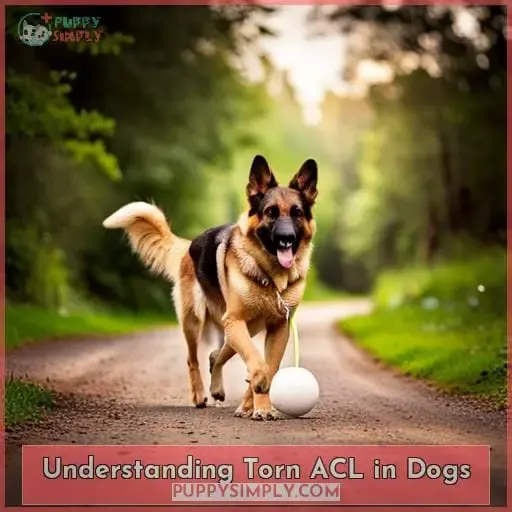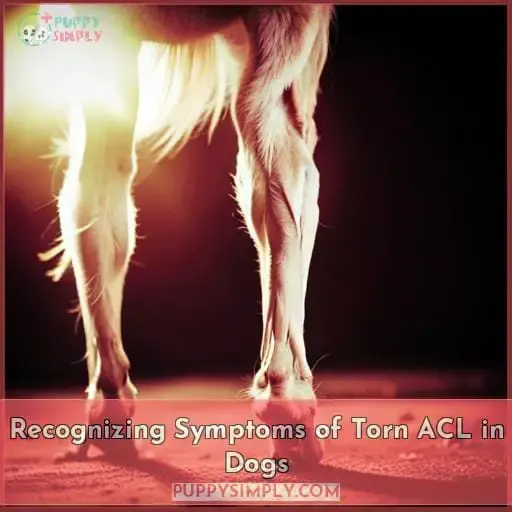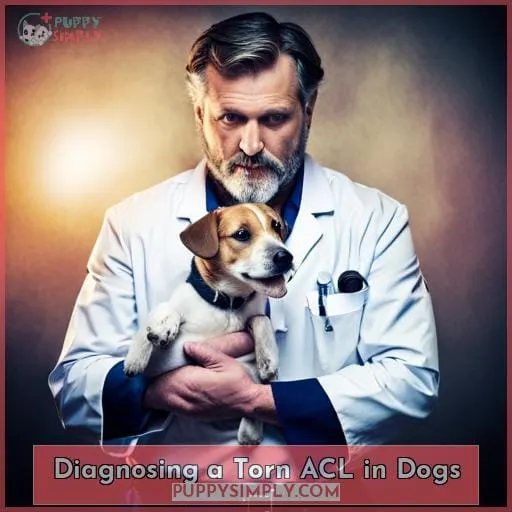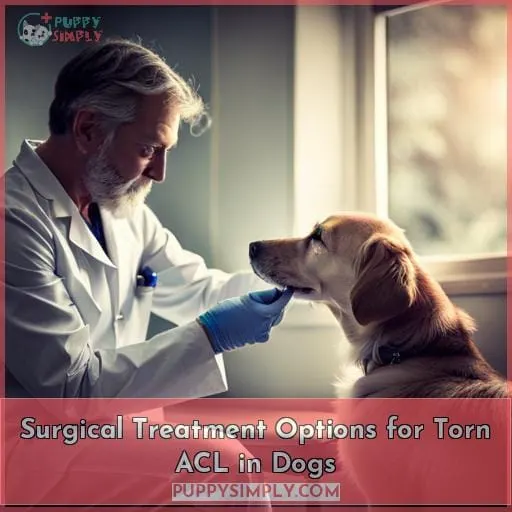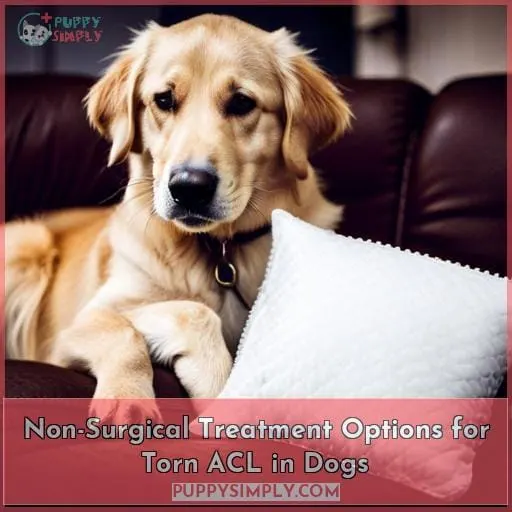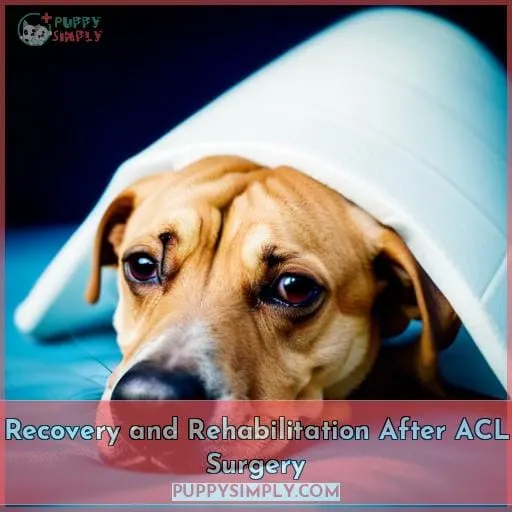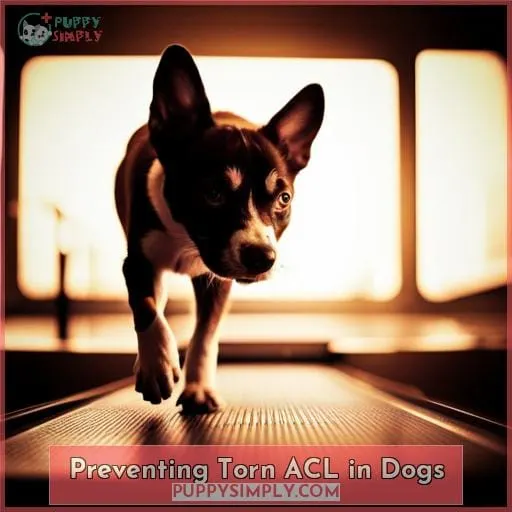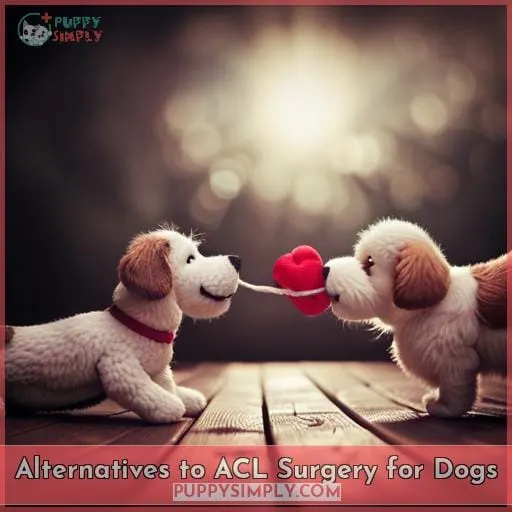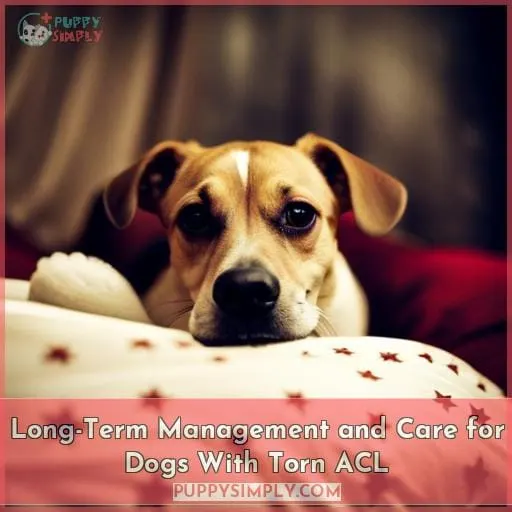This site is supported by our readers. We may earn a commission, at no cost to you, if you purchase through links.
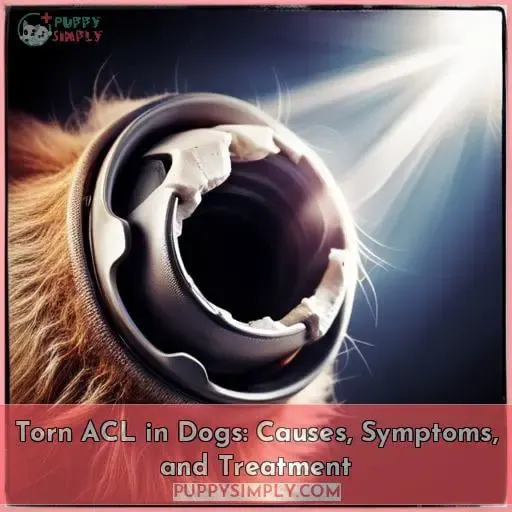 Imagine your beloved dog suddenly limping and in pain. It could be a torn ACL, a common injury in dogs. But don’t worry – there are effective treatments available to help your furry friend recover.
Imagine your beloved dog suddenly limping and in pain. It could be a torn ACL, a common injury in dogs. But don’t worry – there are effective treatments available to help your furry friend recover.
In this article, we will explore the causes, symptoms, and treatment options for torn ACLs in dogs. From surgical interventions like extracapsular repair or Tibial Plateau Leveling Osteotomy (TPLO), to non-surgical alternatives such as rest and physical therapy, we’ll provide you with all the information you need to give your canine companion the best care possible.
Table Of Contents
- Key Takeaways
- Understanding Torn ACL in Dogs
- Recognizing Symptoms of Torn ACL in Dogs
- Diagnosing a Torn ACL in Dogs
- Surgical Treatment Options for Torn ACL in Dogs
- Non-Surgical Treatment Options for Torn ACL in Dogs
- Recovery and Rehabilitation After ACL Surgery
- Preventing Torn ACL in Dogs
- Alternatives to ACL Surgery for Dogs
- Long-Term Management and Care for Dogs With Torn ACL
- Frequently Asked Questions (FAQs)
- Are there any non-surgical treatment options available for torn ACL in dogs?
- How long does the recovery process typically take after ACL surgery in dogs?
- What are the potential complications or risks associated with ACL surgery in dogs?
- Can a torn ACL in dogs heal on its own without any intervention?
- Are there any specific exercises or rehabilitation programs recommended for dogs recovering from a torn ACL?
- Conclusion
Key Takeaways
- Torn ACL is a common injury in dogs, leading to pain, lameness, and instability in the knee.
- Factors such as genetics, body weight, activity level, and previous injury can contribute to a torn ACL in dogs.
- Symptoms of a torn ACL in dogs include pain, lameness, inability to bear weight, swelling, and a clicking or popping sound in the knee joint.
- Treatment options for a torn ACL in dogs include surgical repair and non-surgical options like rest, activity restriction, physical therapy, and medications for pain and inflammation.
Understanding Torn ACL in Dogs
Let’s start by understanding what a torn ACL is in dogs.
The ACL, or cranial cruciate ligament (CCL), stabilizes the knee joint in dogs. It can be torn due to activities that involve twisting motions, such as jumping or running.
Definition and Function of ACL in Dogs
The dog’s ACL, or anterior cruciate ligament, is a crucial stabilizing structure within their knee joint.
It helps to prevent excessive movement and maintain the stability of the knee during activities such as running and jumping.
When torn, it can cause pain and difficulty in mobility for dogs.
Common Causes of Torn ACL in Dogs
One common cause of a torn ACL in dogs is the dog’s participation in high-impact activities such as jumping or running.
The ligament stress from load-bearing during these activities can lead to wear and tear, eventually resulting in an accumulation of stress that causes the ACL to tear.
Age and weight factors, as well as certain susceptible dog breeds with a playful demeanor or obesity, also contribute to the risk of torn ACLs.
Factors That Increase the Risk of Torn ACL in Dogs
To understand the factors that increase your dog’s risk of a torn ACL, it’s essential to consider their:
- Age
- Weight
- Activity level
Large breed dogs are more susceptible, especially at a young age.
Obesity and neutering can also contribute to the likelihood of an ACL tear occurring.
Recognizing Symptoms of Torn ACL in Dogs
To recognize symptoms of a torn ACL in dogs, look out for:
- Limping and lameness, where the dog may avoid putting weight on the affected leg.
- Swelling and pain in the injured knee.
- Difficulty or reluctance to bear weight on one leg.
- Trouble jumping or climbing stairs.
Limping and Lameness
If your dog has a torn ACL, you may notice:
- A significant change in their mobility
- Limping or favoring one leg
Other symptoms of an ACL tear include:
- Joint swelling
- Pain
- Instability
The drawer sign test and tibial thrust test can help diagnose the condition.
Physical therapy can aid in recovery for pain-free playtime.
Swelling and Pain in the Affected Leg
When your dog has a torn ACL, one of the key symptoms to look out for is swelling and pain in the affected leg.
This swelling can be caused by inflammation and fluid buildup in the knee joint.
The severity of swelling can vary depending on the extent of the injury.
Treatment for swelling may involve anti-inflammatory medications or cold compresses to reduce inflammation.
The duration of swelling will depend on how well it responds to treatment and how quickly your dog’s body heals.
To prevent or minimize further swelling, it’s important to follow your veterinarian’s instructions regarding rest, activity restriction, and any prescribed medications or therapies.
Difficulty or Reluctance to Bear Weight
If your dog is experiencing difficulty or reluctance to bear weight on one of their legs, it may be a symptom of a torn ACL.
This can cause swelling, pain, limping, and instability in the affected leg.
It’s important to recognize these symptoms and seek veterinary attention for proper diagnosis and treatment.
Diagnosing a Torn ACL in Dogs
To diagnose a torn ACL in your dog, a veterinarian will perform:
- A physical examination
- Range of motion tests to assess the stability of the knee joint.
One common test used is the drawer sign test, where they manipulate your dog’s leg to check for excessive movement indicating ligament damage.
Imaging techniques such as X-rays or MRIs may also be used to confirm the diagnosis and evaluate any additional damage or underlying conditions.
Physical Examination and Range of Motion Tests
During a physical examination, your veterinarian will assess your dog’s range of motion and perform specific tests to diagnose a torn ACL.
These tests include:
- The drawer sign test
- Tibial thrust test
- Evaluating joint laxity.
Drawer Sign Test
To diagnose a torn ACL in dogs, veterinarians commonly perform the drawer sign test, assessing the stability of the knee joint. This test involves gently manipulating the leg to detect abnormal movement or drawer-like motion.
While it’s highly sensitive and accurate for detecting ACL tears, false negatives and positives can occur, highlighting the importance of additional diagnostic measures.
Imaging Techniques (X-rays, MRIs) for Confirmation
To confirm the diagnosis of a torn ACL in dogs, imaging techniques such as X-rays and MRIs are utilized. These techniques provide valuable information about the extent of damage to the ligament and surrounding structures.
Here’s what you need to know about using X-rays and MRIs for diagnosing a torn ACL in dogs:
- X-rays show torn ACL:
While they may not directly visualize the ligament itself, x-rays can reveal signs of joint effusion (fluid accumulation), bone changes related to chronic instability, or other secondary findings.
- MRI shows torn ACL:
Magnetic resonance imaging (MRI) is considered more accurate than x-rays when it comes to visualizing soft tissues like ligaments. It can clearly depict an injured or completely ruptured anterior cruciate ligament.
- Cost considerations:
Typically, x-ray costs range from $50-$150 per view depending on location and clinic fees; however, additional views might be required for better assessment.
MRIs tend to be pricier with costs ranging from $500-$3000 based on factors like geographic location, facility fees etc.
4.ACL x-ray interpretation vs.MRI interpretation:
-X-ray findings focus on indirect markers of injury while MRI provides direct visualization
-ACL tear may present differently between two modalities
For example,x-raying normal knee could have abnormal subtle finding due its limitations but Mri would clear that up
Surgical Treatment Options for Torn ACL in Dogs
When it comes to treating a torn ACL in dogs, there are several surgical options available.
The most common procedures include:
- Extracapsular repair
- Tibial tuberosity advancement (TTA)
- Tibial plateau leveling osteotomy (TPLO)
These surgeries aim to stabilize the knee joint and restore proper function.
Extracapsular Repair
For the surgical treatment of a torn ACL in dogs, one option to consider is extracapsular repair.
This procedure involves placing a strong suture outside the joint capsule to stabilize the knee.
It has been shown to have good long-term outcomes and lower risk of graft failure compared to other options like TPLO or TTA surgery.
Postoperative recovery and post-operative care are essential for successful outcomes, including monitoring for any postoperative complications and providing additional support as needed.
Tibial Tuberosity Advancement (TTA)
One surgical treatment option for a torn ACL in dogs is TTA, which involves advancing the tibial tuberosity.
TTA surgery aims to stabilize the knee joint by changing its biomechanics. It has a high success rate and fewer complications compared to other procedures.
Recovery time varies, and costs should be discussed with your veterinarian.
Tibial Plateau Leveling Osteotomy (TPLO)
Continuing the discussion on surgical treatment options for torn ACL in dogs, consider Tibial Plateau Leveling Osteotomy (TPLO) as an effective method to stabilize the knee joint and promote healing.
TPLO has a high success rate, though it requires a longer recovery time and can have complications.
The cost of TPLO surgery may vary, but there are alternative non-surgical options available for dog ACL tear treatment.
Non-Surgical Treatment Options for Torn ACL in Dogs
If your dog has suffered a torn ACL, non-surgical treatment options may be available depending on the severity of the injury.
Rest and activity restriction are important to allow for healing and prevent further damage.
Physical therapy and rehabilitation can help strengthen surrounding muscles, improve range of motion, and aid in recovery.
Medications for pain management and inflammation control may also be prescribed by your veterinarian to alleviate discomfort during the healing process.
Rest and Activity Restriction
To manage a torn ACL in your dog without surgery, rest and activity restriction are key components of the non-surgical treatment options.
Limiting exercise and providing adequate rest for 1-2 months is crucial.
Gradual increase in physical therapy over 6-8 weeks can aid in recovery.
Maintaining weight through proper diet and joint supplements is also important for overall management.
Physical Therapy and Rehabilitation
If your dog has a torn ACL, physical therapy and rehabilitation should be consistently incorporated into their recovery plan to promote healing and improve strength.
- Pain management techniques
- Post-operative care
- A specific timeline for recovery exercises
Orthopedic braces can also be considered as an alternative treatment option to surgery for preventing reinjury.
Medications for Pain and Inflammation
For pain and inflammation management in dogs with a torn ACL, veterinarians may prescribe medications to alleviate discomfort and promote healing.
These medications can help reduce swelling, relieve pain, and improve mobility.
It’s important to follow the prescribed dosage instructions and be aware of potential side effects.
The efficacy of these medications may vary depending on the individual dog’s condition.
The duration of treatment will also depend on the severity of the injury and how well the dog responds to medication.
Costs for these medications can vary depending on factors such as brand name or generic options.
Recovery and Rehabilitation After ACL Surgery
After ACL surgery for your dog, post-operative care and monitoring are crucial.
You’ll need to ensure that your dog follows the prescribed rest and activity restrictions to aid in proper healing.
Gradual return to physical activity should be guided by your veterinarian, along with rehabilitation exercises and therapies tailored to support their recovery process.
Post-Operative Care and Monitoring
After ACL surgery, closely monitor your dog’s:
- Post-operative care
- Progress in their recovery and rehabilitation
Follow weight bearing restrictions and gradually increase their activity level.
Take care of the incision by keeping it clean and dry.
Administer prescribed pain medication as directed.
Engage in rehabilitation exercises to aid in their recovery process.
Gradual Return to Physical Activity
Ease your dog back into physical activity gradually after ACL surgery to ensure a safe and successful recovery.
- Follow post-operative care instructions provided by the veterinarian.
- Begin with leash walks and controlled movement.
- Gradually increase exercise duration and intensity over time.
- Incorporate range of motion exercises recommended by the vet.
- Consider supervised rehabilitation sessions or physical therapy for additional support.
Rehabilitation Exercises and Therapies
To aid in the recovery and rehabilitation after ACL surgery, you can incorporate specific rehabilitation exercises and therapies.
These include:
- Range of motion exercises
- Physical therapy to strengthen the quadriceps
- Balance training for proprioception
- Flexibility exercises
- Gait retraining techniques
- Pain management strategies such as acupuncture
Preventing Torn ACL in Dogs
To prevent torn ACL in dogs, it’s crucial to focus on:
- Weight management
- Regular exercise
Maintaining a healthy weight reduces the risk of excessive stress on the ligaments, while controlled and consistent exercise helps strengthen muscles and joints.
Additionally, scheduling regular veterinary check-ups allows for early detection of any potential issues or signs of injury that can be addressed promptly to prevent further damage.
Weight Management and Exercise
To prevent torn ACL in dogs, it’s important for you to manage their weight and encourage regular exercise.
- Weight loss can reduce the strain on their joints.
- Muscle strengthening exercises can provide support.
- Joint supplements like glucosamine may also aid in maintaining joint health.
Controlled exercise with a gradual increase should be promoted, avoiding jumping or sudden movements that could put stress on the ACL.
Rest and rehabilitation are crucial during recovery periods as well.
Avoiding High-Impact Activities
To prevent a torn ACL in your dog, avoid engaging them in high-impact activities such as jumping or sudden changes of direction.
Instead, focus on gentle exercise and low-impact activities like swimming.
If they do need to jump, make sure it’s controlled and ensure proper landing techniques.
Regular Veterinary Check-ups
Regular veterinary check-ups play a crucial role in preventing torn ACLs in dogs by allowing for early detection and intervention.
Through regular exams, veterinarians can identify potential issues with the cruciate ligament and provide necessary treatment to prevent further damage or injury.
Early detection leads to successful treatment outcomes, reducing the risk of complications associated with dog ACL tears.
Alternatives to ACL Surgery for Dogs
If you’re considering alternatives to ACL surgery for your dog, there are a few options worth exploring.
- Orthopedic braces and supports can provide stability to the knee joint and aid in scar tissue formation, promoting healing.
- Conservative management approaches such as rest, anti-inflammatory medications, supplements, acupuncture, swimming therapy or massage may also be considered depending on the severity of the tear and overall health of your dog.
However, it’s important to consult with your veterinarian to determine which alternative is best suited for your specific case.
Orthopedic Braces and Supports
If your dog has a torn ACL, you may consider using orthopedic braces and supports as an alternative to surgery.
There are various types of orthopedic braces available, including knee braces and hinged leg supports.
However, it’s important to weigh the benefits against the drawbacks before choosing a brace for your dog. Consult with your veterinarian to determine the most suitable option for your furry friend’s specific needs.
You can find orthopedic braces at veterinary clinics or online pet supply stores.
Conservative Management Approaches
If surgery isn’t a viable option for your dog’s torn ACL, there are alternative conservative management approaches that can be considered.
These alternatives include:
- Rest and activity restriction
- Physical therapy and rehabilitation
- Medications for pain and inflammation
The efficacy of conservative management varies depending on the severity of the tear, age of the dog, overall health condition, with potential risks including prolonged healing time and reduced long-term stability compared to surgical options.
It’s important to discuss these alternatives with your veterinarian to determine the best course of action for your furry friend’s recovery.
Potential Limitations and Effectiveness
When exploring alternatives to ACL surgery for dogs, it’s important to consider the potential limitations and effectiveness of conservative management approaches.
While these options may be less invasive and costly, they may have limitations in terms of:
- Cost
- Recovery time
- Complications
- Pain management
- Overall quality of life for your furry companion.
Long-Term Management and Care for Dogs With Torn ACL
To ensure the long-term health and well-being of your dog with a torn ACL, ongoing monitoring and follow-up are crucial.
Regular check-ups with your veterinarian will help assess the progress of healing and identify any potential complications.
Additionally, incorporating joint health supplements into their diet can provide support for their joints and promote overall mobility.
Making lifestyle modifications such as maintaining a healthy weight, providing low-impact exercise options, and avoiding activities that put excessive strain on the affected leg can also contribute to long-term joint health in dogs with a torn ACL.
Ongoing Monitoring and Follow-up
To ensure the long-term health and well-being of your dog after a torn ACL, ongoing monitoring and follow-up are essential aspects of their care.
- Regular check-ups with your veterinarian
- Rehabilitation exercises to improve joint strength and flexibility
- Gradually increasing activity levels
- Providing appropriate nutrition and joint health supplements if recommended by your vet
- Making necessary lifestyle modifications to support overall joint health.
Monitoring for signs of improvement is crucial in determining when it’s safe for your dog to return to normal activity levels.
Joint Health Supplements and Nutrition
To ensure the long-term health and well-being of your dog after a torn ACL, focus on joint health supplements and nutrition.
Consider incorporating:
- Glucosamine chondroitin
- Turmeric curcumin
- Omega-3 fatty acids from fish oil
- Other recommended joint supplements
These supplements can help support their recovery and promote overall joint health.
Lifestyle Modifications for Joint Health
To ensure long-term joint health and care for your dog with a torn ACL, it’s important to make lifestyle modifications.
- Weight management through proper nutrition and exercise.
- Incorporating supplements like glucosamine and chondroitin.
- Utilizing cold laser therapy for pain relief.
- Engaging in rehabilitation exercises under professional guidance.
- Implementing rest periods and activity restrictions as recommended by your veterinarian.
- Considering the use of anti-inflammatories or pain medication as necessary.
Frequently Asked Questions (FAQs)
Are there any non-surgical treatment options available for torn ACL in dogs?
Yes, there are non-surgical treatment options for torn ACLs in dogs.
These include:
- Rest
- Anti-inflammatory medications
- Physical therapy
- The use of orthopedic braces to provide support and stability to the knee joint.
How long does the recovery process typically take after ACL surgery in dogs?
After ACL surgery in dogs, the recovery process typically takes around 8 to 12 weeks.
During this time, you’ll need to provide your furry friend with careful supervision and support as they heal and regain their strength.
What are the potential complications or risks associated with ACL surgery in dogs?
Complications and risks associated with ACL surgery in dogs include:
- Infection
- Bleeding
- Anesthesia-related issues
- Implant failure or rejection
Post-surgery complications may include:
- Joint stiffness
- Limited mobility during recovery
Consulting your veterinarian will help address any concerns specific to your dog’s case.
Can a torn ACL in dogs heal on its own without any intervention?
No, your dog’s torn ACL won’t magically heal itself. It’s not a wizard with healing powers!
Surgical intervention is often necessary to ensure proper recovery and prevent further complications.
Are there any specific exercises or rehabilitation programs recommended for dogs recovering from a torn ACL?
To aid in the recovery of a torn ACL, your veterinarian may recommend exercises and rehabilitation programs tailored to your dog’s specific needs.
These can include:
- Controlled movement
- Strength-building exercises
- Hydrotherapy
- Physical therapy sessions
Conclusion
To summarize, a torn ACL in dogs can be a painful and debilitating condition, but there are effective treatment options available.
From surgical interventions like extracapsular repair or TPLO, to non-surgical alternatives such as rest and physical therapy, there are various ways to help your furry friend recover.
It’s important to recognize the symptoms, seek a proper diagnosis, and consult with a veterinarian to determine the best course of action.
By providing the right care and support, you can ensure your dog’s well-being and help them regain their mobility.

